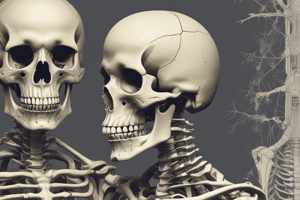Podcast
Questions and Answers
Which division of the skeleton is responsible for locomotion and support?
Which division of the skeleton is responsible for locomotion and support?
- Appendicular skeleton (correct)
- Ribs
- Vertebrae
- Axial skeleton
Which bones make up the axial skeleton?
Which bones make up the axial skeleton?
- Clavicle, scapula
- Tibia, fibula
- Skull, ribs, vertebrae (correct)
- Humerus, radius, ulna
Which bones make up the appendicular skeleton?
Which bones make up the appendicular skeleton?
- Skull, ribs, vertebrae
- Humerus, radius, ulna
- Clavicle, scapula (correct)
- Tibia, fibula
Which joint classification is based on the range of movement?
Which joint classification is based on the range of movement?
Which joint classification is based on the presence or absence of a synovial cavity?
Which joint classification is based on the presence or absence of a synovial cavity?
Which type of joint permits little or no mobility?
Which type of joint permits little or no mobility?
Which type of joint permits slight mobility?
Which type of joint permits slight mobility?
Which type of joint is freely movable?
Which type of joint is freely movable?
Which type of joint is a hinge joint?
Which type of joint is a hinge joint?
Which type of fascia surrounds and separates muscles, compartments, and neurovascular bundles?
Which type of fascia surrounds and separates muscles, compartments, and neurovascular bundles?
Which one of these movements involves the rotation of a body part towards the midline of the body?
Which one of these movements involves the rotation of a body part towards the midline of the body?
Which one of these movements involves the rotation of a body part away from the midline of the body?
Which one of these movements involves the rotation of a body part away from the midline of the body?
Which one of these movements involves the movement of a body part in a circular motion?
Which one of these movements involves the movement of a body part in a circular motion?
Which one of these movements involves the rotation of a body part around its own axis?
Which one of these movements involves the rotation of a body part around its own axis?
Which one of these movements involves the movement of the foot towards the sole of the foot?
Which one of these movements involves the movement of the foot towards the sole of the foot?
Which one of these movements involves the movement of the foot away from the midline of the body?
Which one of these movements involves the movement of the foot away from the midline of the body?
Which one of these movements involves the movement of the jaw forward?
Which one of these movements involves the movement of the jaw forward?
Which one of these movements involves the lifting of a body part?
Which one of these movements involves the lifting of a body part?
Which one of these surrounds and separates muscles, compartments, and neurovascular bundles?
Which one of these surrounds and separates muscles, compartments, and neurovascular bundles?
Which one of these movements involves the movement of a body part away from its anatomical position?
Which one of these movements involves the movement of a body part away from its anatomical position?
Which of the following is NOT a learning outcome of the FunMed Anatomy course?
Which of the following is NOT a learning outcome of the FunMed Anatomy course?
What is the anatomical term for the movement of rotating a limb towards the midline of the body?
What is the anatomical term for the movement of rotating a limb towards the midline of the body?
Which muscle is responsible for extending the fingers?
Which muscle is responsible for extending the fingers?
What is the anatomical term for the movement of rotating a limb away from the midline of the body?
What is the anatomical term for the movement of rotating a limb away from the midline of the body?
Which of the following is NOT a type of joint?
Which of the following is NOT a type of joint?
What is the anatomical term for the movement of bending a limb or joint?
What is the anatomical term for the movement of bending a limb or joint?
Which of the following is NOT a bone learning outcome of the FunMed Anatomy course?
Which of the following is NOT a bone learning outcome of the FunMed Anatomy course?
Which muscle is responsible for abducting the thumb?
Which muscle is responsible for abducting the thumb?
What is the role of fascia in the musculoskeletal system?
What is the role of fascia in the musculoskeletal system?
Flashcards are hidden until you start studying
Study Notes
Skeletal System
- The appendicular skeleton division is responsible for locomotion and support.
- The axial skeleton consists of 80 bones, including the skull, vertebrae, ribs, and sternum.
- The appendicular skeleton consists of 126 bones, including the upper and lower limbs, shoulders, and hips.
Joint Classification
- Joints can be classified based on the range of movement or the presence or absence of a synovial cavity.
- Joints with little or no mobility are classified as immovable joints.
- Joints that permit slight mobility are classified as slightly movable joints.
- Joints that are freely movable are classified as synovial joints.
- Hinge joints are a type of synovial joint that allows movement in one plane only.
Muscle Movement
- Adduction is the movement of a body part towards the midline of the body.
- Abduction is the movement of a body part away from the midline of the body.
- Circumduction is the movement of a body part in a circular motion.
- Rotation is the movement of a body part around its own axis.
- Inversion is the movement of the foot towards the sole of the foot.
- Eversion is the movement of the foot away from the midline of the body.
- Protraction is the movement of the jaw forward.
- Elevation is the lifting of a body part.
- Extension is the movement of a body part away from its anatomical position.
Fascia
- Fascia surrounds and separates muscles, compartments, and neurovascular bundles in the musculoskeletal system.
Muscle Function
- The extensor digitorum muscle is responsible for extending the fingers.
- The thenar muscles are responsible for abducting the thumb.
Anatomical Terms
- Medial rotation is the anatomical term for rotating a limb towards the midline of the body.
- Lateral rotation is the anatomical term for rotating a limb away from the midline of the body.
- Flexion is the anatomical term for bending a limb or joint.
Studying That Suits You
Use AI to generate personalized quizzes and flashcards to suit your learning preferences.





